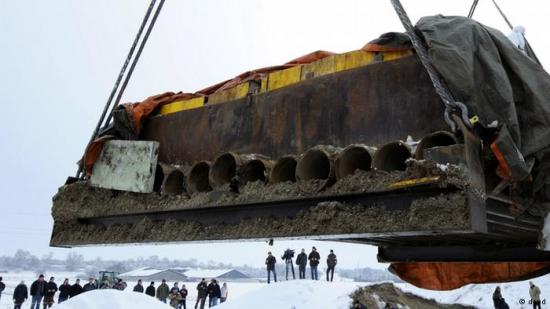Source - http://www.dw.de/secrets-of-a-celtic-princess/g-18088352
The 2,600-year-old burial chamber of the "Celtic Princess of the Danube" was first discovered near Stuttgart in 2010. Four years later, it's still puzzling archaeologists.

Unsolved mysteries
The burial chamber of the "Celtic Princess of the Danube" unearthed in 2010 remains one of the most important archeological finds of the past decades in Germany. A new exhibition in Stuttgart allows the public to contemplate the riches found in the 2,600-year old grave. Even in plain view, the princess holds on to many secrets which keep puzzling archeologists.

An ancient Celtic village
A golden brooch found in 2010 led to a spectacular archaeological discovery: a grave filled with burial objects. The site was hiding just a short distance away from Heuneburg, a settlement in the South of Germany which used to be held by a Celtic prince. It's the largest known pre-historic settlement north of the Alps, where up to 10,000 people were living from 620 to 470 BC.

Another final journey
In order to analyze its contents in detail, archaeologists decided to remove the whole burial chamber from the earth. A 6-by-7.5-meter steel and concrete encasement weighing 80 tons was put on a truck and carried to a laboratory near Stuttgart equipped with the most modern research tools.

She was an aristocrat
The archaeologists made an astonishing discovery: The grave belonged to a member of the Celtic nobility. Most graves of this kind had been plundered centuries ago, but this one was still filled with magnificent burial objects, detailed ornamental jewelry made of gold, amber pearls, and bronze artifacts. Such items were only buried with particularly important figures of Celtic society.

Two women and a girl
A two- or three-year-old child was also found in the grave. Archaeologists presume she was the daughter of the princess, as she was wearing similar precious jewelry. The third woman buried with them is a riddle: This skeleton was in the same chamber near the princess, but didn't have as many precious burial items with her. Maybe the maid?

Precision work
Experts go into painstaking detail to find out as much as possible about these three people. For now, DNA tests couldn't determine any relationship between the three figures, as the bones are too deteriorated. Archaeologists hope technology will improve quickly enough to provide more information over the next few years. The research is set to continue until 2018.

Knock on wood
The water flowing near the burial site helped preserve the wood used to build the burial chamber, which made it possible for archaeologists to date it very precisely. The wood comes from a fir tree cut in the year 583 BC. According to Dirk Krausse, who is in charge of the dig, "It is the oldest princely female grave yet from the Celtic world."

Who was she?
Who exactly was the mysterious princess? The answers are still limited for now. She was between 30 and 40 years old and had remarkably good teeth. The torso of her skeleton was still complete, but the head was located three meters away and her lower jaw was in another corner. It's unclear what that means.

A strong network
The burial objects do reveal some details of Celtic society which were unknown until now. An ornamental armor for horses found next to the unidentified woman was not typical of the region. This object might have come from northern Italy, whereas other elements came from the South. Celts were therefore involved in more interregional trade than archaeologists had previously thought.
Secrets exhibited
No one knows whether the mysteries preserved in this astonishing grave will ever be solved. Archaeologists expect to spend many more years on the case. Before the artifacts go back to the lab for research, the secrets of the Celtic princess are on display in an exhibition center in the courtyard of the New Palace in Stuttgart through December 14, 2014.